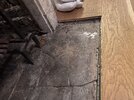- Joined
- 12 Feb 2023
- Messages
- 10
- Reaction score
- 0
- Country

Hi there!
I am relatively new to DIY and would appreciate some advice on how to level my fireplace.
Currently the fireplace is lower than the floorboard (up to 3cm) , and I am planning to fill it with self levelling concrete/ compound to bring to the same level. However, I am not sure how I should seal off the floorboard edges to protect from self levelling concrete? If you look closer at the photo below, there are two layers of floorboard (original and new) and they are not completely even. I thought about using a trim but not sure if it will work if the layers of the floorboard is sticking out at different height. How should I seal the edge of the floorboard in my case?
Any advice would be super helpful.
I am relatively new to DIY and would appreciate some advice on how to level my fireplace.
Currently the fireplace is lower than the floorboard (up to 3cm) , and I am planning to fill it with self levelling concrete/ compound to bring to the same level. However, I am not sure how I should seal off the floorboard edges to protect from self levelling concrete? If you look closer at the photo below, there are two layers of floorboard (original and new) and they are not completely even. I thought about using a trim but not sure if it will work if the layers of the floorboard is sticking out at different height. How should I seal the edge of the floorboard in my case?
Any advice would be super helpful.

